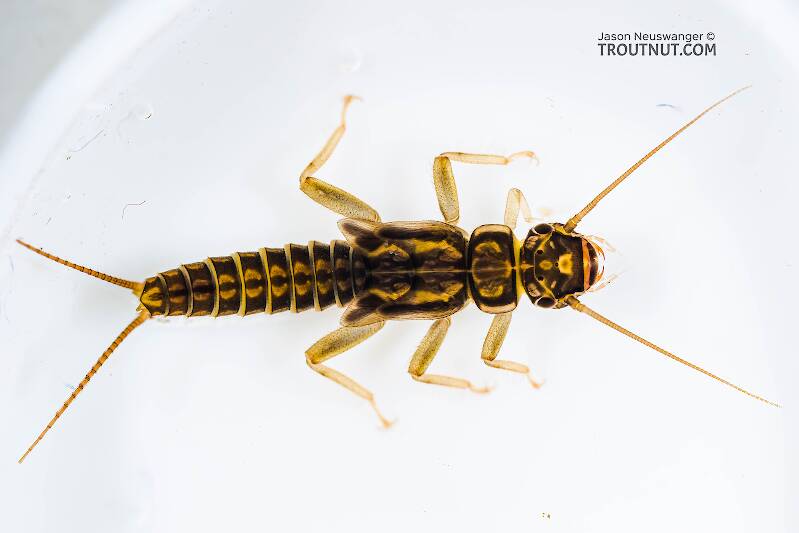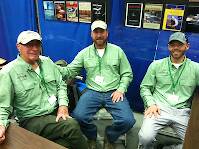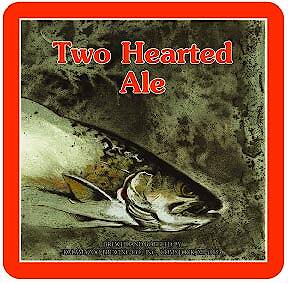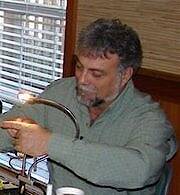
Hex Mayflies
Hexagenia limbata
The famous nocturnal Hex hatch of the Midwest (and a few other lucky locations) stirs to the surface mythically large brown trout that only touch streamers for the rest of the year.
Featured on the forum


Troutnut is a project started in 2003 by salmonid ecologist Jason "Troutnut" Neuswanger to help anglers and
fly tyers unabashedly embrace the entomological side of the sport. Learn more about Troutnut or
support the project for an enhanced experience here.
Keystoner on Oct 30, 2010October 30th, 2010, 12:49 am EDT
Hey Guys, been flyfishing for about a year now. I feel like I'm getting a pretty good grasp on the basic fishing techniques, so, I'm looking to test the waters of tying. As with fishing I feel like the ol' babe in the woods here, that said, any info you'd care to share would be greatly appreciated.
Specifically I'm wondering what kind of tools I'll want to get, and maybe a resource other than this site for tying instruction. Know any good books, websites, teachers, etc??
I'm looking to start out with pheasant tails and streamers(buggers) since that mainly what I've been using. As always, thanks in advance!!!
Specifically I'm wondering what kind of tools I'll want to get, and maybe a resource other than this site for tying instruction. Know any good books, websites, teachers, etc??
I'm looking to start out with pheasant tails and streamers(buggers) since that mainly what I've been using. As always, thanks in advance!!!
"Out into the cool of the evening, strolls the Pretender. He knows that all his hopes and dreams, begin and end there." -JB
Softhackle on Oct 30, 2010October 30th, 2010, 3:01 am EDT
Hi,
One of the best sites I've come across is Charlie's Fly Box. Here's a link:
Charlie's Fly Box
If you look to the right in the list click on the "Flybox" listing. This will bring you to the gallery. On the left is a list, with photos of various flies. Click on the fly you want to see. This will bring you to the fly, with a photo, list materials and a link to a tying tutorial for the fly. This should help.
Also, a good book is always helpful. I start people out on The Art Of Fly Tying by John Van Vliet. It also comes as a CD that can be played on the computer. It covers wets, dry's, streamers, etc. It shows how to do everything from wrapping bodies to tying dry fly wings and is fairly inexpensive.
The CD
The Book
I'm sure others here will suggest some resources as well.
Welcome to the forum,
Mark
One of the best sites I've come across is Charlie's Fly Box. Here's a link:
Charlie's Fly Box
If you look to the right in the list click on the "Flybox" listing. This will bring you to the gallery. On the left is a list, with photos of various flies. Click on the fly you want to see. This will bring you to the fly, with a photo, list materials and a link to a tying tutorial for the fly. This should help.
Also, a good book is always helpful. I start people out on The Art Of Fly Tying by John Van Vliet. It also comes as a CD that can be played on the computer. It covers wets, dry's, streamers, etc. It shows how to do everything from wrapping bodies to tying dry fly wings and is fairly inexpensive.
The CD
The Book
I'm sure others here will suggest some resources as well.
Welcome to the forum,
Mark
"I have the highest respect for the skilled wet-fly fisherman, as he has mastered an art of very great difficulty." Edward R. Hewitt
Flymphs, Soft-hackles and Spiders: http://www.troutnut.com/libstudio/FS&S/index.html
Flymphs, Soft-hackles and Spiders: http://www.troutnut.com/libstudio/FS&S/index.html
Aaron7_8 on Oct 30, 2010October 30th, 2010, 4:40 am EDT
I have found You Tube to be extremely helpful in seeing different methods of tying and use of different materials. It works well, there are some scetchy video, but you can always find something useful in most of the videos.
Ericd on Oct 30, 2010October 30th, 2010, 11:51 am EDT
I've taken two tying classes by two different instructors that have helped me out a lot. The first class taught me how to tie a lot of different flies and the second taught me that there are innumerable ways to tie those same flies.
I love that there are no rules. Well, someone will give you a rule and after a few times at the vise you'll find a great way to break it.
My tying season has just begun.
I love that there are no rules. Well, someone will give you a rule and after a few times at the vise you'll find a great way to break it.
My tying season has just begun.
FredH on Nov 1, 2010November 1st, 2010, 2:42 am EDT
Hi Keystoner and welcome to the obsession. The tools you will need can cost anywhere from $30 - several hundred depending on your budget. Cabelas has a kit that is ok for beggining tiers at around $30 . It is not a high end tool kit but it has the basics you'll need to get started and not break the bank. If you decide to buy your tools piece mill then you will spend quite a bit more, but you will have tools that will not need to be replaced or upgraded. The basics you will need include a vise , scissors, bobin , bodkin , hackle pliers,whip finisher and tweezers. There are other specialty tools like dubbing tools and hair packers that can be added later if you want them.
Materials . Buy hooks for the patterns you'll want to start with and specific materials ro do those patterns. Once you are comfortable with those you can research other patterns that utilize the same materials. Some forums even have a fly database that can be searched by materials used to tie them.And if your area has fly fishing club , join . There is probably a wealth of hands on experience to be had there.
Fred
Materials . Buy hooks for the patterns you'll want to start with and specific materials ro do those patterns. Once you are comfortable with those you can research other patterns that utilize the same materials. Some forums even have a fly database that can be searched by materials used to tie them.And if your area has fly fishing club , join . There is probably a wealth of hands on experience to be had there.
Fred
PaulRoberts on Nov 1, 2010November 1st, 2010, 3:55 am EDT
I guess I'd advise not getting carried away thinking you need all the tools right away. Starting with a few flies you have confidence in is a good way to go. For Buggers and PT's you'll need a vice, a bobbin, rubber-lipped hackle plier, 6/0 thread, and a whip finisher. (I use clear nail polish instead of head cement.) Get a good quality name brand model of each individually. Not sure I'd suggest you get a "kit" -at least from what I've seen of most beginner's kits. Others may have a good suggestion on good kits here. You might end up with cheap tools and poor quality materials you'll end up replacing anyway. That was the case for many of my student tiers. Get a name brand vice, bobbin, plier, and whip finisher (ball-bearing type). You can make/scrounge a lot of other tools as as you go: bodkins, dubbing hooks, dubbing picks, various size hair-stackers, etc... But first you have to need them. As you add patterns to your box you'll begin to acquire stuff.
When I taught tying, I offered the representative types: dry, streamer, nymph. Wets are so much like nymphs or streamers I didn't feel the need highlight them at that point. Then I chose representative patterns that would demonstrate various techniques: tails (dry and wet), winding hackle, dubbing bodies, wings, wing cases, legs, flash, etc... After knowing some of the basic techniques you can expand to other fly needs and even invent your own (don't be afraid to play). I keep fly catalogs in my tying library that show commercial flies available. They can give you ideas to jump off from.
Some very basics on proportion: Visually, break the hook into parts: point, bend, shank, eye. For most patterns you tie on the shank –but NOT just behind the eye where the fly’s head will go, as so many beginning tiers end up crowding the head because they didn't pre-plan proportion. That area behind the eye where the fly head will be is called the “Dreaded Red Zone” (so-called by Joe Cambridge, notable Ithaca NY tier/angler). Now break up the remaining shank (minus the DRZ): For most insect ties, tails go at the bend, abdomen tends to occupy half the shank, thorax/wings, and legs, the remaining half.
In my advanced course, we'd head to the stream to capture critters, then study them in terms of anatomy, mobility, contexts in which fish capture them, and finally, how to select and use materials to get there. It was a lot of fun and taught anglers some pretty important stuff, like: where food items actually live, that anatomically correct in hand does not often translate to realism in front of fish, that flies designed for a specific task can at times outfish a generic pattern by a lot, or conversely, that what fish will take for "food" can at times be amazingly simple -"What are they stupid??" No, they can be selective, or not, they just don't see like us, and fishing conditions/circumstances matter a whole lot.
Have fun. You're getting into a very cool game.
When I taught tying, I offered the representative types: dry, streamer, nymph. Wets are so much like nymphs or streamers I didn't feel the need highlight them at that point. Then I chose representative patterns that would demonstrate various techniques: tails (dry and wet), winding hackle, dubbing bodies, wings, wing cases, legs, flash, etc... After knowing some of the basic techniques you can expand to other fly needs and even invent your own (don't be afraid to play). I keep fly catalogs in my tying library that show commercial flies available. They can give you ideas to jump off from.
Some very basics on proportion: Visually, break the hook into parts: point, bend, shank, eye. For most patterns you tie on the shank –but NOT just behind the eye where the fly’s head will go, as so many beginning tiers end up crowding the head because they didn't pre-plan proportion. That area behind the eye where the fly head will be is called the “Dreaded Red Zone” (so-called by Joe Cambridge, notable Ithaca NY tier/angler). Now break up the remaining shank (minus the DRZ): For most insect ties, tails go at the bend, abdomen tends to occupy half the shank, thorax/wings, and legs, the remaining half.
In my advanced course, we'd head to the stream to capture critters, then study them in terms of anatomy, mobility, contexts in which fish capture them, and finally, how to select and use materials to get there. It was a lot of fun and taught anglers some pretty important stuff, like: where food items actually live, that anatomically correct in hand does not often translate to realism in front of fish, that flies designed for a specific task can at times outfish a generic pattern by a lot, or conversely, that what fish will take for "food" can at times be amazingly simple -"What are they stupid??" No, they can be selective, or not, they just don't see like us, and fishing conditions/circumstances matter a whole lot.
Have fun. You're getting into a very cool game.
Shawnny3 on Nov 1, 2010November 1st, 2010, 5:45 am EDT
Good advice here. A few older threads on here about beginning flytying:
http://www.troutnut.com/topic/541#2186
http://www.troutnut.com/topic/705
http://www.troutnut.com/topic/1645
-Shawn
http://www.troutnut.com/topic/541#2186
http://www.troutnut.com/topic/705
http://www.troutnut.com/topic/1645
-Shawn
Jewelry-Quality Artistic Salmon Flies, by Shawn Davis
www.davisflydesigns.com
www.davisflydesigns.com
Wbranch on Nov 1, 2010November 1st, 2010, 5:53 am EDT
I don't know where you live but Bass Pro offers numerous beginner fly tying courses during the winter. Also sometimes Gander Mountain may offer a fly tying course and finally a local TU chapter may be offering courses for beginners.
Catskill fly fisher for fifty-five years.
Keystoner on Nov 1, 2010November 1st, 2010, 12:40 pm EDT
Holy Smokes!! Thanks guys, boat load of info here!!
I haven't spent any money yet, but I did do some surveying at Cabela's over the weekend, and spent a couple hours turning Barnes&Noble into a library. There does seem to be a drastic curve on quality and price regarding tools. It seem to go from apparent cheap crap to top dollar with no in between. Money IS an issue for me so I'm just kinda mellowing and soaking up info right now. Don't wanna buy junk, but also can't afford top dollar at the moment. Nonetheless thanks again for all the guidance. I am really excited to get started!!
I haven't spent any money yet, but I did do some surveying at Cabela's over the weekend, and spent a couple hours turning Barnes&Noble into a library. There does seem to be a drastic curve on quality and price regarding tools. It seem to go from apparent cheap crap to top dollar with no in between. Money IS an issue for me so I'm just kinda mellowing and soaking up info right now. Don't wanna buy junk, but also can't afford top dollar at the moment. Nonetheless thanks again for all the guidance. I am really excited to get started!!
"Out into the cool of the evening, strolls the Pretender. He knows that all his hopes and dreams, begin and end there." -JB
Ericd on Nov 1, 2010November 1st, 2010, 1:31 pm EDT
I plan on buying a decent vise someday, but the vise and the rest of the tools that I have been using for about a year now all came from one of those cheap kits. They are a great way to start. I will say that a vise with one of those bobbin holders off to the side would be very helpful for me although I've been managing just fine without.
PaulRoberts on Nov 1, 2010November 1st, 2010, 2:38 pm EDT
The old standard starter vice was the Thompson A. I still have one -my son uses it. It's a perfectly good vice -or was. I think they still make it. My first vice was a Thompson knock-off that lasted a year of light use, then I wore it out (the pot metal disintegrated) the next. Ericd is right, an inexpensive vice will get you started. Heck, you can tie by hand! I can still whip finish by hand as quick as a BB whip-finisher. Where there's a will, there's a way.
Oldredbarn on Nov 2, 2010November 2nd, 2010, 3:24 am EDT
The old standard starter vice was the Thompson A.
Paul,
That vise was probably the work horse, and first vise, for all of us guys who have been around awhile. I have probably mentioned it here before but my fishing mentor actually tied commercially and used that vise for years. He tied for local judges here in Detroit when he was a young man and for Rusty Gates' Au Sable Lodge (both for Rusty and his dad Calvin Gates Sr when he was still alive) and did it all with that vise. All he did was replace jaws that had worn out. He finally replaced it with a HMH probably because it was a nicer version of the simple Thompson.
I replaced my Thompson with a Dyna King Pro and love it...You can set it to work with a rotary like function but I have never done that...Probably because I started with a simple Thompson as well and just never caught the rotary bug. It wasn't a "cheap" vise but I love it and will use it until I can't tie any longer.
I also agree that as a new hobby for someone that they should just start out with some good essential tools and see how it goes. We use to joke that there were only two type of fly fishermen...Those that are obsessed period and those leaving the sport...The trick is to find those that have given it up and make them an offer for all that "stuff" they purchased when they thought fly fishing was going to be the end all and be all!
On a more positive note though, I get a great deal of personal pleasure from fooling a trout with something I've tied or a good friend has offered me to try. Classes can be a great help and the sharing of ideas usually flows freely...It's really hard for a fly tyer to really keep his mouth shut, no matter what he says, and he'll usually want to show off a bit and will eventually show you his last seasons "secret fly". :)
My friend would say when he was teaching me that the only way to improve is to tie and your 2nd dozen will look better than the 1st...and so on.
Spence
"Even when my best efforts fail it's a satisfying challenge, and that, after all, is the essence of fly fishing." -Chauncy Lively
"Envy not the man who lives beside the river, but the man the river flows through." Joseph T Heywood
"Envy not the man who lives beside the river, but the man the river flows through." Joseph T Heywood
Shawnny3 on Nov 2, 2010November 2nd, 2010, 4:15 am EDT
Don't wanna buy junk, but also can't afford top dollar at the moment.
As others have said, buy what you need and nothing else, but try to buy decent-quality stuff, adding to your arsenal as need requires.
The two places in my opinion beginners ought not to drop a lot of money is on dry-fly hackles and a vise, both of which can be obscenely expensive and are not necessary expenses to get started. Get a decent vise that holds hooks in a range of sizes securely. If you must tie dries (which are more difficult to tie well than they look), you can always buy half-necks or even small packs of hackles to get you started. Many of today's saddles are also getting surprisingly good for tying dries and are cheaper than necks. Generally you do get what you pay for with necks and saddles, but as a beginner you don't need to buy a lifetime supply of professional-grade materials, unless you're tying hundreds of dries in really small sizes, which is probably a bad way to start anyway.
-Shawn
Jewelry-Quality Artistic Salmon Flies, by Shawn Davis
www.davisflydesigns.com
www.davisflydesigns.com
PaulRoberts on Nov 2, 2010November 2nd, 2010, 4:42 am EDT
Good stuff here.
Yeah, "secret" flies often make me chuckle. As if only one fly will do it. But, that said, I have a few (chuckle). Actually I have flies that have solved a problem so well that it feels criminal lol. I have one, that I won't share yet, only because I have the article written with images ready (15 years ago!) but I cannot find a source for the "special" material it requires. I cannot introduce a cool problem solver and then say, but "I dunno where you can get the stuff". My supply is meager too. I've mailed a section of it to a number of manufacturers and nobody knows where it's made. Bummer. I'm still dumpster diving (in the right places) in hopes of finding more. Since I DO want to share (and get all smug feeling inside n all), I will say it's a Hydropsychid diver that well...makes the water churn at the right time and place. It's one of those flies that pretty much fishes itself. Makes me all giggly just thinking about it. :)
Dry fly hackle: Bad hackle can be a real hassle. But, there are SO many ways and materials to float a hook it just isn't necessary. Except maybe on fast turbulent waters as it's hard to beat keeping the dubbing up outta the drink in such water.
Yeah, "secret" flies often make me chuckle. As if only one fly will do it. But, that said, I have a few (chuckle). Actually I have flies that have solved a problem so well that it feels criminal lol. I have one, that I won't share yet, only because I have the article written with images ready (15 years ago!) but I cannot find a source for the "special" material it requires. I cannot introduce a cool problem solver and then say, but "I dunno where you can get the stuff". My supply is meager too. I've mailed a section of it to a number of manufacturers and nobody knows where it's made. Bummer. I'm still dumpster diving (in the right places) in hopes of finding more. Since I DO want to share (and get all smug feeling inside n all), I will say it's a Hydropsychid diver that well...makes the water churn at the right time and place. It's one of those flies that pretty much fishes itself. Makes me all giggly just thinking about it. :)
Dry fly hackle: Bad hackle can be a real hassle. But, there are SO many ways and materials to float a hook it just isn't necessary. Except maybe on fast turbulent waters as it's hard to beat keeping the dubbing up outta the drink in such water.
Oldredbarn on Nov 2, 2010November 2nd, 2010, 8:30 am EDT
Actually I have flies that have solved a problem so well that it feels criminal
Paul! Paul! Paul! You must be one hell of an angler! You now have a couple hundred guys probably zapping you PM's trying to drag the info from you...We are all lined up like greedy Browns in the middle of the Hex hatch...You sure know your audience! :)
Don't you just hate it though when you run out of some particular material that's been your favorite for so long...A good Partridge skin with little living in the wild damage to the feathers. Last year I purchased a whole pheasant skin from BRF in W Yellowstone that is so beautiful it was all I could do to pluck a feather from it. Or maybe a beloved neck that is just the right shade of dun (according to ourselves of course)and was used to tie up untold numbers of flies...
Years ago my friend and I would pilfer through old drawers at fly shops in Detroit & Grayling and snag such good cheap imported dyed necks with just the perfect shape for traditional mayfly wings...This is a missed pleasure with so many of the old shops around here going under or gone and the obsession with the new genetic hackle...It was like waiting for a new comic book to come out when we were kids or a new record from our favorite bands back in the 60's and early 70's.
I was real lucky when I started to tie because of my friends knowledge and experience. Our early tying sessions were priceless. He made me buy things I had no idea what for until my own skill and knowledge grew and a light would go off and I'd nearly scream, "This is perfect! I forgot I even had this!" He loved this story when I told him...It was one of those, "I told you so!" moments we all love.
I've had some great times with this tying hobby once I got my material control up to speed and figured out ways to master some of the more frustrating things and make them easy to do. It's nice after years of tying to be able to look at some new fly from someone and de-construct it in your head and then re-create it.
My friend use to be freewheeling and would show me everything until the day he finally realized I was getting it and committing his flies to memory...He's a little more reluctant these days. I remember the day he saw me staring intently at a fly he had shown me and then said, "Hey! Wait a minute...Give me that fly back mister...Don't burn a hole in it."
He came back from out west one year and I went over to check out his pictures and get a fishing report. He let me check out what he had used for his hopper pattern...When I got home I drew, from memory, what I remembered seeing...I still have those drawings.
I have some special cases/fly boxes etc where I have labeled and stored flies from friends that they have given me over the years...When I first started tying I would set them up where I could see them and tried to make my attempt an exact copy...It was good practise and an eye opener in terms of where you were at skill wise,. If you could be honest with yourself about it...
Spence
"Even when my best efforts fail it's a satisfying challenge, and that, after all, is the essence of fly fishing." -Chauncy Lively
"Envy not the man who lives beside the river, but the man the river flows through." Joseph T Heywood
"Envy not the man who lives beside the river, but the man the river flows through." Joseph T Heywood
PaulRoberts on Nov 2, 2010November 2nd, 2010, 1:32 pm EDT
Paul! Paul! Paul! You must be one hell of an angler! You now have a couple hundred guys probably zapping you PM's trying to drag the info from you...We are all lined up like greedy Browns in the middle of the Hex hatch...You sure know your audience! :)
I have some special cases/fly boxes etc where I have labeled and stored flies from friends that they have given me over the years...
Oldredbarn on Nov 4, 2010November 4th, 2010, 6:42 am EDT
Paul,
My tying space is a nice place to hang. I have a big screen TV across the room for the Wings games and one big corner of the basement's all mine...I have a couple nice built in bookcases for my fishing and bird books, an old Hope Chest for my materiels, and a big closet to store gear etc...Also a frig and bathroom...I am spoiled!
A picture is out there somewhere when we were showing off our tying space in some earlier thread...If I can find it I'll bump it up so you can look.
I will tell you honestly that I would like to convince a nephew in to learning what I'm up to down there. It is fun sharing and I miss my old tying sessions/lessons with my old mentor. I get worried when I think I'm talking to myself down there and more concerned when I think I'm answering myself back! :)
That's part of the reason I still hang out with a local TU tying group at a nearby middle school during the winter months...It's good to bounce some things off others from time-to-time. Keeps me human somewhat.
Spence
When I use to run in to fella's on the river that knew my tying friend they were always trying to peak in my boxes to see what Bill was up to these days...It was nice, on a personal level, when I began to have a hard time telling mine and his models apart...It was even better one time when I heard him tell a mutually respected angling buddy that Spence is tying some "fishable flies" these days...I still haven't had him fish one of mine...I'm not holding my breath! :)
My tying space is a nice place to hang. I have a big screen TV across the room for the Wings games and one big corner of the basement's all mine...I have a couple nice built in bookcases for my fishing and bird books, an old Hope Chest for my materiels, and a big closet to store gear etc...Also a frig and bathroom...I am spoiled!
A picture is out there somewhere when we were showing off our tying space in some earlier thread...If I can find it I'll bump it up so you can look.
I will tell you honestly that I would like to convince a nephew in to learning what I'm up to down there. It is fun sharing and I miss my old tying sessions/lessons with my old mentor. I get worried when I think I'm talking to myself down there and more concerned when I think I'm answering myself back! :)
That's part of the reason I still hang out with a local TU tying group at a nearby middle school during the winter months...It's good to bounce some things off others from time-to-time. Keeps me human somewhat.
Spence
When I use to run in to fella's on the river that knew my tying friend they were always trying to peak in my boxes to see what Bill was up to these days...It was nice, on a personal level, when I began to have a hard time telling mine and his models apart...It was even better one time when I heard him tell a mutually respected angling buddy that Spence is tying some "fishable flies" these days...I still haven't had him fish one of mine...I'm not holding my breath! :)
"Even when my best efforts fail it's a satisfying challenge, and that, after all, is the essence of fly fishing." -Chauncy Lively
"Envy not the man who lives beside the river, but the man the river flows through." Joseph T Heywood
"Envy not the man who lives beside the river, but the man the river flows through." Joseph T Heywood
PaulRoberts on Nov 4, 2010November 4th, 2010, 7:45 am EDT
Sounds nice Spence. Wish I had time to wish for more time... like that spent hanging out and tying with buddy's. I'm lucky if I can get the flies tied I need, much less those rolling around in my head. I've pulled together a tying space in my office and...just...can't...quite...get over there to so much as open a hook box. :(
Keystoner on Dec 9, 2010December 9th, 2010, 11:19 am EST
Just returned from purchasing my "tying starter kit". I got a 15 dollar Cabela's vice, a Dr. Slick tool set (a little pricey, but not too bad), and all the ingredients I'll need to start tying zebra midges. I was a little bummed because I couldn't find a true barbless hook in the size and shape that I wanted. Now that I am planning on tying my own stuff (or at least some of it),I'd like to be using actual barbless hooks, and not smashed barb hooks. The ones I got will be fine for now though. I picked zebra midges because they seemed pretty simple, and a good place to start. Plus, that's what I'm fishing now anyway!!
Thanks for all the great stuff you guys posted an here! I'm sure the questions will continue as I move further into it. Thanks again!!! This site, and the people on it, are a big part of why I feel confident to tackle tying less than a year after picking up a fly rod for the first time ever.
Thanks for all the great stuff you guys posted an here! I'm sure the questions will continue as I move further into it. Thanks again!!! This site, and the people on it, are a big part of why I feel confident to tackle tying less than a year after picking up a fly rod for the first time ever.
"Out into the cool of the evening, strolls the Pretender. He knows that all his hopes and dreams, begin and end there." -JB
Aaron7_8 on Dec 9, 2010December 9th, 2010, 1:53 pm EST
Good luck and don't let it get you down, it is just like fishing it can frustrate you to the point of wanting to break things, or be the easiest thing you have done in a while, sometimes fifteen minutes apart. Keep us posted.
Quick Reply
Related Discussions
Topic
Replies
Last Reply
Make your own fly Reel and other new classes at the CFFCM Arts of the Agnler Show
In General Discussion by Flymom
In General Discussion by Flymom
0
Oct 1, 2009
by Flymom
by Flymom
Re: We all must wish Tilman, one of our Germans, a Merry Christmas...
In General Discussion by Oldredbarn
In General Discussion by Oldredbarn
2
Dec 18, 2009
by Martinlf
by Martinlf
Re: Three Trouble Makers at the Midwest Fly Fishing Expo the past weekend

In the Photography Board by Oldredbarn

In the Photography Board by Oldredbarn
3
Mar 11, 2014
by TNEAL
by TNEAL








